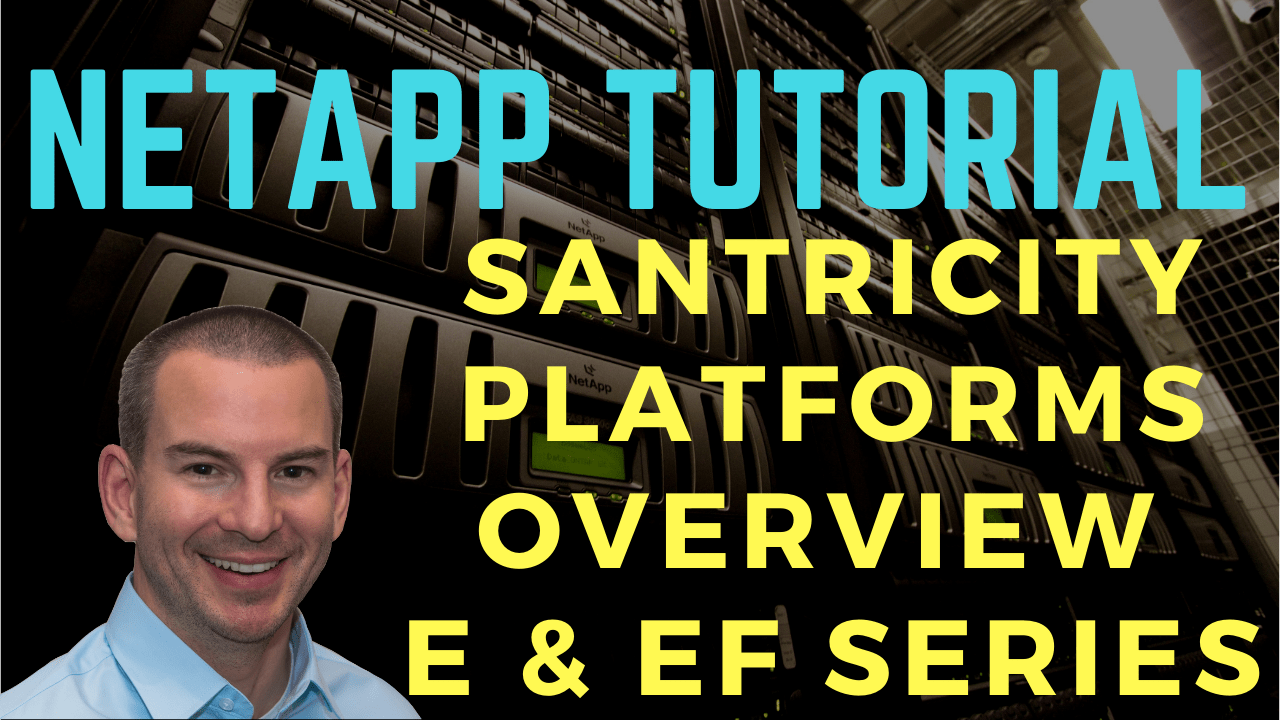
In this NetApp training tutorial, I’ll give you an overview of NetApp’s E and EF-Series platforms that run on the SANtricity operating system. Scroll down for the video and text tutorials.
The E-Series and EF-Series platforms provide simple, easy to manage, fast, and reliable block storage.
NetApp SANtricity Platforms Overview Video Tutorial

Lance Candia

Concise detailed information. Neil is not vague about his explanation. He provides some “what if’s” as well as “for instances” which again take out any ambiguity pertaining to the training. He stays on point, doesn’t go off topic or on a tangent. He keeps it relevant with some historical or legacy information where it makes sense. Overall I would use the word to sum up this training as “impressive”.
The EF-Series are all flash arrays, so that's kind of like AFF with ONTAP. The E-Series, on the other hand, are hybrid, meaning they support SSDs, just like EF-Series, and they support spinning discs as well. It is like FAS systems on ONTAP.

E-Series and EF-Series run on the SANtricity operating system. The systems are dual active controllers, hence, you don't get big clusters with lots of nodes like with ONTAP. All of the systems are two controllers and both are active at the same time, therefore, they're both servicing clients.
The client access for our block level access is either direct-attached storage (DAS) over SAS cables or it is remote SAN. It supports Fibre Channel, iSCSI, InfiniBand, and NVMeOF.
The platform offers raw storage to clients and also has additional features such as snapshots and replication. It's not just a bunch of discs providing raw block storage. It's more of an app because it does have some features as well.

The feature set is, however, basic. The SANtricity systems are built for low overhead and a lot of speed. ONTAP systems support varied workloads, and lots of different features, thus, known as the Swiss army knife.
SANtricity systems are referred to as the dragster of the NetApp storage portfolio, meaning, they're very fast, but you don't get all the features as you do with ONTAP.
SANtricity systems don't have their own file system. It is managed at a higher level by the client operating system or application. Furthermore, SANtricity was evolved from the acquisition by NetApp of Engenio in 2011.
E/EF-Series Use Cases
The use cases for the E and the EF-Series is very high in performance. So, for any kind of database which requires high performance, the E and the EF-Series is a good bet.
E and the EF-Series are suitable if you want a simple, fast, and reliable storage for a single workload. It does support the direct attach storage with SAN protocols for this matter.

Other use cases:
- Backup and recovery where storage features, such as deduplication and compression are managed by the backup software rather than being managed by the storage system as you would do with ONTAP.
- Video surveillance. CCTV cameras require good performance and are also pulling in a large amount of streaming video data.
- Technical high-performance computing. For example, Lustre and GPFS.
- Artificial intelligence, big data, and analytics. For example, if you're running Splunk database, Hadoop, et cetera.
SANtricity on E-Series and EF-Series Systems
To have a look at E-Series and the EF-Series, go to NetApp.com and click on products. On the right, you can see the EF-Series and the E-Series products.
In the EF-Series page, we would see the E5700 and the E2800. With all the NetApp platforms, it's always the bigger the number, the bigger the system. Meaning there are more capacity and performance.
The E2800 systems support both SSD and the spinning discs, and you can get up to 300,000 IOPS in the system at 1.8PB of raw capacity. On the E5700, it's up to 1,000,000 IOPS and scales to 6PB of capacity.

On the EF-Series, we have the EF280, which looks like the E2800. EF570, which looks like the E5700. You would see the chassis is actually basically the same.
Even if they have similar hardware, the EF-Series allows SSDs only and they've been performance tuned for that all flash SSD only disc. You're going to see exactly the same specs on EF280 as well.
Disk Shelves
Just like our FAS and our AFF systems, we can get the extra capacity by adding disk shelves to those controllers.

Additional Resources
Description of E-Series and EF-Series Systems: https://netapp.github.io/openstack-deploy-ops-guide/icehouse/content/section_e-ef-series.html
Intro to the E-Series family of storage systems: https://docs.netapp.com/us-en/e-series-family/intro-family.html
Click Here to get my 'NetApp ONTAP 9 Storage Complete' training course.
Libby Teofilo

Text by Libby Teofilo, Technical Writer at www.flackbox.com
Libby’s passion for technology drives her to constantly learn and share her insights. When she’s not immersed in the tech world, she’s either lost in a good book with a cup of coffee or out exploring on her next adventure. Always curious, always inspired.